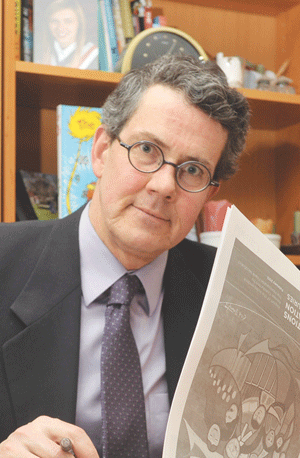Former Supreme Court justice Frank Iacobucci’s recommendations for increasing representation of First Nations people in juries are actions long overdue, some aboriginal lawyers are saying.

Iacobucci’s report, released last week, said the relationship between the justice system and First Nations people is “quite frankly in crisis.” Iacobucci was appointed by the provincial government to examine why so few aboriginal people sit on juries in Ontario.
Despite being convicted in high numbers by the criminal justice system, First Nations people don’t have sufficient representation among the people tasked with deciding their fate.
In 17 recommendations, Iacobucci urged the government to create a database of First Nations people who live on reserves so the list can be used to reach out to individuals for jury duty. He also suggested the government make information on the role of jurors available to First Nations people in their own languages, pay jurors in amounts consistent with the cost of living, and amend the language used in jury questionnaires.
“Today, First Nations peoples see themselves either as spectators to or victims of the justice system, whereas historically they were direct participants in the resolution of conflict within their own communities,” Iacobucci says in the report.
The report “ties the jury issue to the overall estrangement of aboriginal people from the criminal justice system,” says Jonathan Rudin, program director at Aboriginal Legal Services of Toronto. “You can’t solve the jury issue without recognizing those things.”
The Ministry of the Attorney General said it plans to immediately adopt Iacobucci’s first two recommendations, which ask the government to create an implementation group and an advisory committee to oversee application of new measures.
“Since no solution to increasing First Nation representation on jury rolls can occur without working directly with First Nation partners, we will form an implementation committee that includes representatives from the First Nations community and from various government ministries,” Attorney General John Gerretsen said in a press release.
Currently, there isn’t a single list of the names and addresses of First Nations people living on reserves, says Rudin.
Iacobucci suggests the government uses OHIP records to gain access to names of those living on reserves. Although provinces like Manitoba are already using health card information for jury duty purposes, Ontario is still not up to speed, says Rudin.
“The fact that Manitoba uses health card information has been known since the 1990s. Ontario knew there were other ways of doing it.”
For jury duty selection purposes, the Ontario government normally uses the Municipal Property Assessment Corporation’s (MPAC) database, which doesn’t include aboriginals living on reserve, says Rudin.
“The problem with the jury system right now is that it lacks credibility with minority communities, with black communities, with aboriginal communities, and with lots of ethnic communities in Canada,” says David McRobert, who is a member of the Ontario Bar Association’s aboriginal law executive committee.
“And why is that? Because they don’t see themselves often on those juries and they feel that their particular values are not reflected on those juries.”
In a case involving the 2007 death of Jacy Pierre, a member of the Fort William First Nation near Thunder Bay, Pierre’s family withdrew from the inquest after neither the coroner nor the attorney general responded to their request that a member of the First Nations community sit on the jury.
Rudin, who represents the Pierre family, says the case remains stalled.
But according to Iacobucci’s report, lack of access to communities and language barriers aren’t the only reasons for the absence of aboriginal people on juries. Some cultural teachings of First Nations people are incompatible with the duty jurors are expected to fulfil.
“The traditional aboriginal justice process was aimed at restoring the offender and the victim to a place of harmony, peace, healing, and reconciliation,” says the report. “Because criminal trials require the jury to make a finding of guilt or innocence, which potentially affects a person’s future in a negative way, many First Nations people feel unwilling to participate in that process.”
Iacobucci adds that when questionnaires are sent to potential jurors, citing fines for non-response, First Nations communities view it as “imposing jury duty through intimidation and threat.” He suggests the government use language that is less likely to be perceived as a warning.
However, Iacobucci notes: “The First Nations people with whom I met expressed a willingness and desire to work towards a reconciliatory model of justice that respects and incorporates First Nations traditional values and laws as a matter of self-governance within Canada’s justice system.”
Dianne Corbiere, a partner with Nahwegahbow Corbiere, says it’s “high time” Ontario implemented the recommendations in the report, including finding a way of incorporating traditional aboriginal laws into the justice system.
“We’re not about just including us. We’re about recognizing that we have our own tradition and laws,” she says, adding that recommendations like Iacobucci’s have been brought up before by organizations such as the Canadian Bar Association and the Indigenous Bar Association.
“The time for studying this issue is over,” she says. “This is a time for real, fundamental action.”
For his part, Iacobucci also wrote that ignoring the issues would be shameful.
“Doing nothing will be a profound shame, especially when there has been a greater recognition throughout Canada of the tragic history of aboriginal people, with many examples of mistreatment, lack of respect, unsound policies, and most importantly a lack of mutual trust between aboriginal and non-aboriginal people,” he wrote.

 Iacobucci’s report, released last week, said the relationship between the justice system and First Nations people is “quite frankly in crisis.” Iacobucci was appointed by the provincial government to examine why so few aboriginal people sit on juries in Ontario.
Iacobucci’s report, released last week, said the relationship between the justice system and First Nations people is “quite frankly in crisis.” Iacobucci was appointed by the provincial government to examine why so few aboriginal people sit on juries in Ontario.